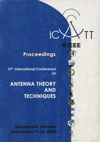Waveguide bend matched by the stepped miter
DOI:
https://doi.org/10.1109/ICATT.2003.1238860Keywords:
waveguide bend, mode-matching techniqueAbstract
The 2D problem of the stepped mitered waveguide bend is considered for both E and H polarizations of incident waves. The method used for analysis is the mode-matching technique (MMT). Geometric parameters of such a device that can provide a low level of return loss within the whole operating frequency band are found for WR90. It is proved that even 4 steps are enough to match the device to better than -30 dB.References
Shestopalov, V.P.; Kirilenko, A.A.; Rud, L.A. Waveguide Discontinuities. Kyiv: Naukova Dumka, 1986 (in Russian).
Labay, V.A.; Bornemann, J. Generalized Scattering Matrix of Waveguide Comers Distorted by Discontinuities in the Resonator Region. IEEE MTT-S Digest, 1995, p. 269-272.
Kirilenko, A.A.; Kulik, D.Y.; Tkachenko, V.I.; Kulishenko, S.F. Generalization of the Mode-Matching Technique for the T-junction with Inner Metallic Insert. Radiophysics and Electronics, 2001, Vol. 6, No. 2-3, p. 181-186.
Ma, Z.; Yamane, T.; Yamashita, E. Studies on the Characterization and Optimal Design of E-Plane Waveguide Bends. IEICE Trans. Electron., Nov. 1997, Vol. E80-C, No. 11, p. 1395-1401.
Published
2003-09-28
Issue
Section
Microwave components and circuits, fiber-optic links

